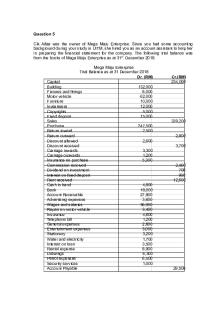ENT 4024 - 10 - ENT 4024-003: Entrepreneurship PDF

| Title | ENT 4024 - 10 - ENT 4024-003: Entrepreneurship |
|---|---|
| Course | Entrepreneurship |
| Institution | Florida Atlantic University |
| Pages | 3 |
| File Size | 36.8 KB |
| File Type | |
| Total Downloads | 83 |
| Total Views | 133 |
Summary
ENT 4024-003: Entrepreneurship...
Description
disaster loan - an SBA loan to a small business devastated by some kind of financial or physical loss
nonbank sources of debt capital - Asset-based lenders Vendor financing Equipment suppliers Commercial finance companies Savings-and-loan associations Stockbrokers Credit unions Private placements Small business investment companies
advance rate - the percentage of an asset's value that a lender will lend
margin loan - a loan from a stockbroker that uses the stocks and bonds in the borrower's portfolio as collateral
margin (maintenance) call - a situation that occurs when the value of a borrower's portfolio drops and the broker calls the loan in, requiring the borrower to put up more cash and securities as collateral
credit union - a nonprofit financial cooperative that promotes saving and provides loans to its members
small business investment companies (SBICs) - privately owned financial institutions that are licensed by the SBA and use a combination of private capital and federally guaranteed debt to provide long-term venture capital to small businesses
other federal and state programs - - Economic Development Administration (EDA) - Department of Housing and Urban Development - U.S. Department of Agriculture's Business Program and Loans - Small Business Innovation Research Program
- Small Business Technology Transfer Program - State and Local Loan Development Programs
capital access program (CAP) - a state lending program that encourages leading institutions to make loans to businesses that don't qualify for traditional financing because of their higher risk
revolving loan funds - community programs that combine private and public funds to make loans to small businesses, often at below-market interest rates
Time out of cash - The total cash it will take to sustain the business until the business achieves breakeven cash flow
return on investment - the percentage of the total cost of purchasing an investment and the profit made from selling that investment
Customer Segments - groups of people who share similar needs and thus are likely to desire the same features in a product
value proposition - a collection of product and service features that is both attractive to customers and different than competitors' offerings
Customer Relationshsips - Not every business provides the same type and same level of customer service.
Channels - Refer to both communication (promotion) and distribution (product placement).
Key Activities - The goal is to build a basic checklist of what needs to be done to open the business and what activities are necessary to ensure its long-term success.
Key resources - Supports a successful launch to sustain the business as it grows.
Key partners - the network of suppliers and partners that make the business model work
Revenue Streams - Serves as the framework for the more detailed revenue forecasts developed for the business plan.
cost structure - The framework for developing more detailed costs that entrepreneur will incorporate into financial forecasts of the business plan
(1) the reality test (2) the competitive test (3) the value test - Three reasons for developing a business plan
Executive Summary - Be concise and focused. This may be all potential investors read. Include a very brief financial summary and show why you need the money and what's in it for the investor. 1-1 1/2 Pages.
Mission statement - Brevity and honesty are key. 1-2 Sentences.
Company History - What gave you the idea to engage in this business?...
Similar Free PDFs

Ent Net - Ent Net
- 14 Pages

BMC ENT
- 15 Pages

ENT 530 - CASE Study
- 12 Pages

ENT BUSINESS PLAN
- 68 Pages

Mega Maju Ent QQ
- 2 Pages

ENT 300 CASE Study
- 11 Pages

ENT 10 Intro sce po 10 de 10
- 11 Pages

BMC ENT - Examples assignment
- 33 Pages

Conf Correo Ent Medusa
- 17 Pages

Macro 1516 td2 ent
- 5 Pages

ENT en difficultés cours
- 25 Pages

PIChap 1Sect2 2B ENT
- 4 Pages

Case Study ENT
- 15 Pages

Public Speaking Cheat Sheet ent
- 2 Pages
Popular Institutions
- Tinajero National High School - Annex
- Politeknik Caltex Riau
- Yokohama City University
- SGT University
- University of Al-Qadisiyah
- Divine Word College of Vigan
- Techniek College Rotterdam
- Universidade de Santiago
- Universiti Teknologi MARA Cawangan Johor Kampus Pasir Gudang
- Poltekkes Kemenkes Yogyakarta
- Baguio City National High School
- Colegio san marcos
- preparatoria uno
- Centro de Bachillerato Tecnológico Industrial y de Servicios No. 107
- Dalian Maritime University
- Quang Trung Secondary School
- Colegio Tecnológico en Informática
- Corporación Regional de Educación Superior
- Grupo CEDVA
- Dar Al Uloom University
- Centro de Estudios Preuniversitarios de la Universidad Nacional de Ingeniería
- 上智大学
- Aakash International School, Nuna Majara
- San Felipe Neri Catholic School
- Kang Chiao International School - New Taipei City
- Misamis Occidental National High School
- Institución Educativa Escuela Normal Juan Ladrilleros
- Kolehiyo ng Pantukan
- Batanes State College
- Instituto Continental
- Sekolah Menengah Kejuruan Kesehatan Kaltara (Tarakan)
- Colegio de La Inmaculada Concepcion - Cebu

